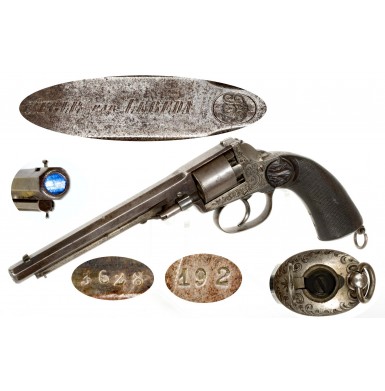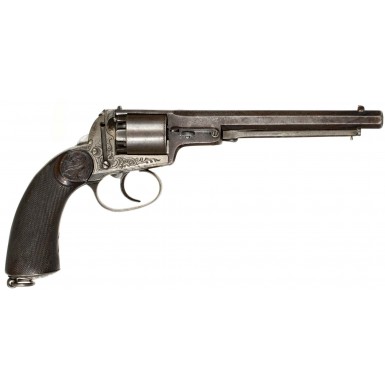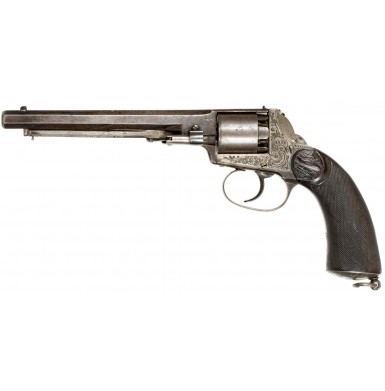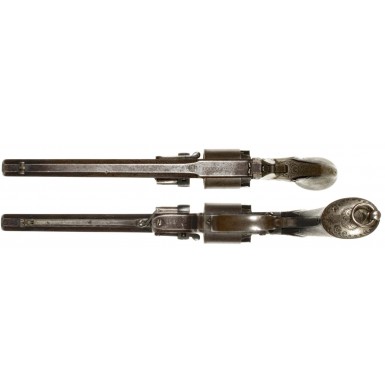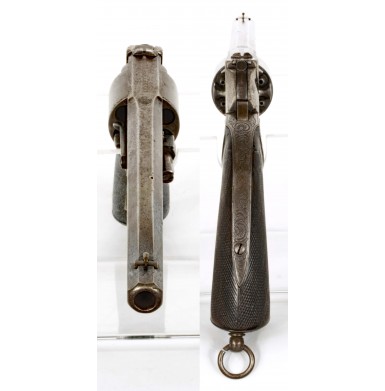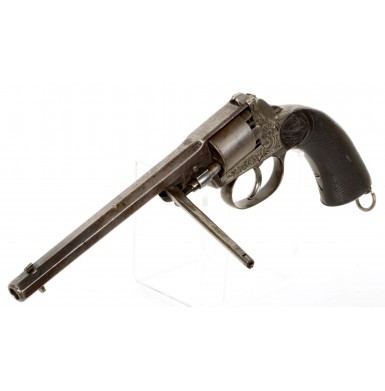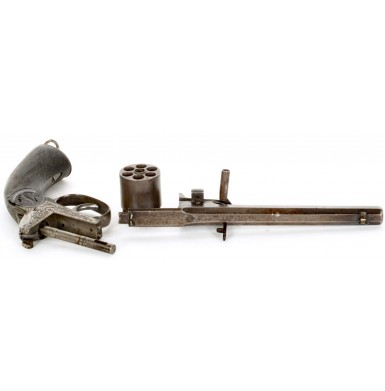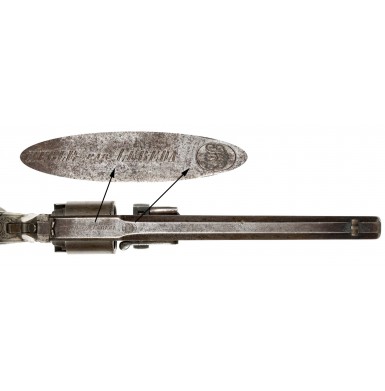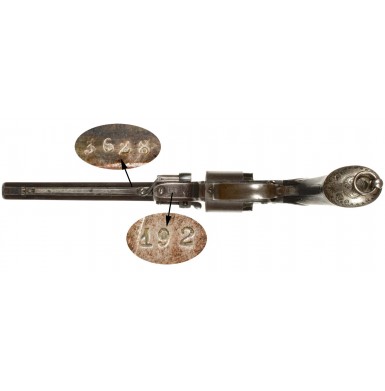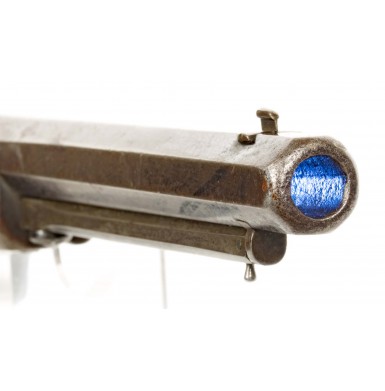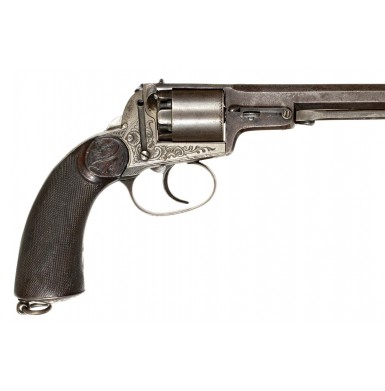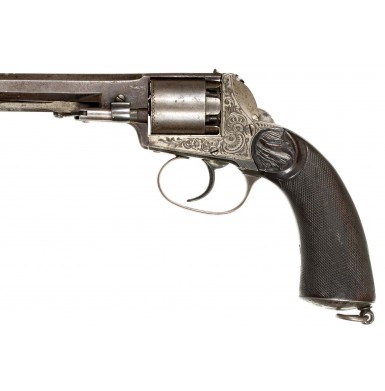Extremely Rare Percussion Revolver by Antonin Lebeda of Prague
- Product Code: FHG-2136-SOLD
- Availability: Out Of Stock
-
$1.00
Antonin Vinzenc Lebeda was born on May 1, 1795 in Cernesice, Bohemia near Prague. Both cities are now part of the Czech Republic, but during the period of Lebeda’s life much of that modern country was referred to as Bohemia and was part of the larger Austrian and later Austro-Hungarian Empire. Lebeda was from a family of farmers but was apprenticed to be a gunsmith in the nearby city of Prague at the age of twelve. Upon the completion of his apprenticeship at the age of eighteen, Lebeda traveled to Wien (Vienna) and initially worked under a master gunsmith named Contriner, likely Joseph Contriner who worked circa 1798-1848, and was the father of a family of Viennese master gunsmiths that included Franz, Johann and Johann Baptist. From Vienna, Lebeda pushed on and traveled through most of Continental Europe, working here and there for various master gunsmiths and learning the most advanced European gunmaking techniques of the period. Circa 1820, Lebeda took over the existing gunmaking business of Matyas Brandies (Brandejs) who worked in the Prague suburb of Karlin. Lebeda passed as a master gunsmith some two years later, submitting a pair of high quality rifle locks for inspection and being raised to the level of master within the guild. He moved the former Brandejs business to the center of Prague and by 1829 was the first Czech gunsmith to receive a patent for improvements to firearms. His patent was for a new lock design, where the entire mechanism was operated by a single spring and that was further unique in that if any of the internal assembly screws were to break or become damaged, the lock would still function. He referred to the design as the Kastenschlass or “Prague Lock.” This design was in fact basis for all back action locks that would be produced in the future, a design that was particularly popular throughout Europe and Great Britain during the 19thcentury.
Over the next few years, Lebeda continued to produce high quality and innovative firearms that gained him great notoriety both in Bohemia and throughout Europe. By 1831, he was employing eighteen workmen in his business and was starting to produce arms for some of the royalty of Europe. His first royal client was the Bohemian Prince Kamil Rohan, whose titles included Duke of Montbazon and Bouillon, and Prince of Guéméné and Rochefort. The sale of the high quality sporting rifle to the prince provided an entrée for Lebeda into the world of Europe’s elite ruling class. As Lebeda’s reputation grew, so did his business. By 1835, he was granted the right to refer to his facility as a “factory” and was also given permission to use the Imperial Eagleas a sign of his work’s quality and the government sanction of the quality of his arms. This was similar to English gunmaking titles like “maker to his royal highness” or similar. By 1841, Lebeda’s factory was employing between forty and fifty workers on a regular basis, as well as six full-time engravers. The majority of the Lebeda output during this period appears to have been high quality sporting arms, including rifles, shotguns, target and dueling pistols; which were usually sold cased in pairs. Part of the Lebeda quality was a direct result of the high prices that he charged for his work. His prices allowed him to pay his workmen well, thus allowing him to maintain a workforce of the best gunsmiths, which included Alois Brandejs who appears to have been the son of the man whose business Lebeda had acquired. Lebeda’s work was of such high quality and he was so well known in his time that he was considered the “Bohemian Boutet” and with the addition of his sons Antonin and Ferdinand and to the business he was on the verge of establishing a gunmaking dynasty that would rival that of the Kuchenreuter family. Eventually, Lebeda’s customers included the King of Sweden, the Czar of Russia, the Duke of Braunschweig, the King of Hanover, and the Austrian Emperor Franz Joseph to name a few. Franz Joseph would order “twelve double barreled shotguns, six double rifles and three over and under shotguns” from Lebeda. Franz Joseph was so pleased with the guns that he awarded Lebeda the title of Court Supplier. These guns were all delivered in 1850, the last year that Lebeda was actively involved with the business. That year he became sick and handed over day to day operations of the business to his older son Antonin. Antonin Lebeda the elder died on July 2, 1857. The firm remained in business through 1888, but Lebeda was not forgotten as the Czech’s honored him with a commemorative postage stamp issue in 1969.
During his working life, Lebeda established the practice of keeping detailed day and log books, with all of the arms produced being logged by number in the book. The arms included detailed drawings and notes, allowing his to document all of his work. These detailed pattern books also included sketches of engraving and carving and detailed every gun that he made from the establishment of his own business in May of 1820 through the end of the company in May of 1888, some sixty-eight years later.
While researching Antonin V. Lebeda’s history and work, I relied heavily upon a wonderful article by late American Society of Arms Collector’s member H.H. Thomas printed in the ASAC Bulletin 51 from a presentation that he gave at the Colorado Springs, CO meeting of the Society in 1978. His research included a number of Czech sources that are not readily available, and his work has been invaluable in writing this description.
Offered here is an extremely rare percussion revolver by Antonin Lebeda, or possibly by his eldest son Antonin. While researching the gun and the family gunmaking history I found several examples of his work, including rifles, shotguns and single shot pistols but found no revolvers. The gun is a classic example of a circa 1850s double action percussion revolver that shows heavy English influences and classic European styling. The revolver is what would be called “double action only” today and has no facility to cock the hammer manually. Pulling the trigger rotates the cylinder and raises, then releases the hammer to fire the pistol. The mechanism shows both Adams and Bentley influences, including a frame mounted spring safety (now missing) on the right side, behind the cylinder. This spring safety would allow the pistol to be placed on a “half cock”, freeing the cylinder to rotate for loading and would automatically disengage when the trigger was pulled. A similar system was used on the French Perrin revolver as well. The pistol has a two-piece frame design with the barrel and top strap making up one major component and the lower frame and grip strap made as the other major component. The backstrap is also a separate piece. The frame is secured by a wedge that is held in place by a pivoting lever secured to the right side of the barrel by a screw. Raising the lever allows the wedge to be drawn out of the left side of the barrel and allows the barrel and topstrap to be separated from the frame. When secured together, the two pieces are indexed by a pair of pins on the lower front of the frame and by the topstrap engaging a slot in the upper rear of the frame, above the hammer nose. The revolver has a six-shot cylinder with nominally .36 caliber chambers. The octagonal barrel is nominally 7-inches in length, measuring 6 15/16-inches. It is rifled with six-grooves and measures about .365-inches at the forcing cone and about .356-inches at the muzzle. The most intriguing feature of the revolver is the loading lever, which pivots from the side. When the lever is unlocked, it can be pivoted to the left, which then forces the plunger that is mounted along the left side of the frame into a chamber. Like many percussion revolvers of the period, the gun includes a storage compartment for percussion caps in the buttcap. A lanyard ring is attached to the butt of the revolver as well. Sights include a small notched rear sight mounted on the rear of the topstrap and a dovetailed blade near the muzzle. The revolver shows the quality of the work done in the Lebeda shop and the frame is profusely engraved with foliate arabesque scrolls, with the backstrap and butt cap engraved en-suite. The front edge of the cylinder is engraved with a beaded boarder line. The topstrap is engraved in a single line:
REGLE par LEBEDA
This appears to be French, with the literal translation “Rule by Lebeda”. More likely, the colloquial translation would be something implying the gun was a “royal quality” gun by Lebeda or possibly that Lebeda was a royal manufacturer. Other markings on the pistol include an intertwined letter cipher on the topstrap that is not fully legible, a small Crown / Y proof on the left side of the barrel in front of the cylinder and an unknown mark on the cylinder. The bottom of the barrel web is numbered 192, and the bottom of the barrel is numbered 3628. I originally felt the 3628 number was a serial number and the 192 was an assembly number. I still think that “3628” is the serial number, but the “192” does not appear anywhere else. As such, I think the “192” may refer to a model or style number and would relate to the patterns in the Lebeda day book. The revolver is blued and has checkered one-piece grips that appear to be walnut, with raised carved leaf patterns where the grip meets the frame.
The pistol remains in about VERY GOOD condition overall and retains some of the original blued finish. The blue is primarily confined to the bottom of the barrel where it has been protected by the loading lever, with only traces of blue here and there on the barrel. The balance of the pistol has a mottled gray and oxidized brown patina with some scattered light pitting and moderate surface roughness here and there. This is most apparent at the muzzle and along the edges of the topstrap. All of the markings and engraving remain relatively crisp and clear. The pistol is completely functional and operates as it should. The revolver times, indexes and locks up correctly when the trigger is pulled. As noted above, the frame mounted spring safety is missing. The cylinder retains five original cones (nipples), with one appearing to be an old, period of use replacement. The lid for the cap compartment in the butt of the revolver remains functional and closes securely. The pivoting latch that secures the wedge is somewhat loose and the wedge can be removed accidently while handling the gun due to the somewhat loose tolerances between the wedge and latch. If the latch screw could be tightened this might be improved. The bore of the revolver is in about FAIR condition and shows moderate to heavy pitting along its length, which is more severe near the muzzle. Both original sights are in place and the lanyard ring appears to be original as well. The grip is in about VERY GOOD condition and is solid and complete with no breaks or repairs. The checkering shows light-to-moderate wear with some flattening and small areas of smoothed wood. The carving remains crisp at the top of the grips. The grip shows numerous scattered bumps, dings and mars, but as noted remains is solid, complete condition and shows no abuse.
Overall, this a very nice example of a very scarce percussion revolver produced by one of the most famous Bohemian gunsmiths of the 19thcentury. While guns by Lebeda do appear on the market in Europe from time to time, and are in many institutional collections, they are exceedingly rare in America; especially private collections. Additionally, I could find no records of any sales (or even the existence) of any other revolvers by Lebeda. This is a rare European revolver by an acclaimed Czech maker that would be a wonderful addition to any serious percussion revolver collection and may be the only chance you will ever have to acquire one.
SOLD
Tags: Extremely, Rare, Percussion, Revolver, by, Antonin, Lebeda, of, Prague

